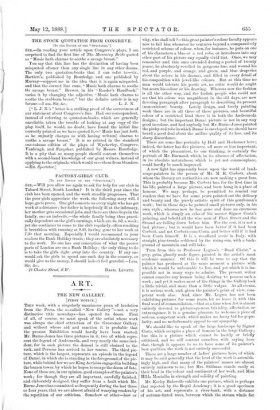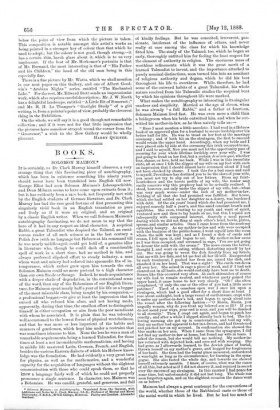ART.
THE NEW GALLERY.
[FIRST NOTICE.]
THIS week, with a singularly unanimous pan of laudation from the Press, the so-called "New Gallery "—not a very distinctive title nowadays—has opened its doors. First of all, of course, we must speak of the artist whose work was always the chief attraction of the Grosvenor Gallery, and without whose aid and sanction it is probable that the present Exhibition would hardly have been started. Mr. Burne-Jones has three pictures in it, two of which repre- sent the legend of Andromeda, and very nearly the same inci- dent, for in each picture the damsel is still chained to the rock, and Perseus has arrived to her rescue. The third pic- ture, which is the largest, represents an episode in the legend of Dana, in which she is standing in the foreground of the pic- ture, while behind her we see King Acrisius engaged in building the brazen tower, by which he hopes to escape the doom of fate. None of these are, in our opinion, good examples of the painter's work; for though they are all important, carefully finished, and elaborately designed, they suffer from a fault which Mr. Burne-Jones has committed BO frequently during the last three or four years, that we are almost afraid of wearying readers by the repetition of our criticism. Somehow or other—how or why, who shall tell P—this great painter's colour faculty appears now to fail him whenever he ventures beyond a comparatively restricted scheme of colour, when, for instance, he puts on one of his characters a blue or a red robe, or introduces into any other part of his picture any equally vivid tint. Once, we may remember (and this once extended during a period of twenty years), he absolutely revelled in gorgeous hue, and wound his red, and purple, and orange, and green, and blue draperies about the actors in his dramas, and filled in every detail of his composition with jewel-like colours. But at this time no man would tolerate his poetic art, no critic would do aught but scorn his colour or his drawing. Whereas now the fashion is all the other way, and the foolish people who could not see that his colour was magnificent in the old days, are now devoting paragraph after paragraph to describing its present (non-existent) beauty. Lovely design, and lovely painting work there are in all three of these pictures, and beautiful colour of a restricted kind there is in both the Andromeda designs ; but the important Danae picture is not in any way good in colour, and had anybody but Mr. Burne-Jones painted the pinky-red robe in which Danae is enveloped, we should have heard a good deal about the aniline quality of its hue, and its sharp discordance.
There are some fine portraits by Holl and Herkomer here; indeed, the latter has five pictures, all more or less important, of which the pleasantest, to our thinking, is certainly the portrait of Mr. Burnand, which, in its absence of affectation, in its absolute naturalness, which is yet not commonplace, could hardly be much improved.
A new light has apparently burst upon the world of land- scape-painters in the person of Mr. M. R. Corbett, about whom the literary art authorities are now making a great fuss. This is probably because Mr. Corbett has, for the first time in his life, painted a large picture, and been hung in a place of honour. We may, perhaps, be permitted to remind our readers that we have for some years pointed out the delicacy and beauty and the purely artistic spirit of this gentleman's work ; but in those days he painted small pictures only, in his own style ; whereas now he has gone and done an enormous work, which is simply an echo of his master Signor Costa's painting, and behold all the wise men of Fleet Street and the Strand are falling down before him. For the rest, it is not a bad picture ; but it would have been better if it had been Corbett, and not Corbett-cum-Costa, and better still if it had been Costa himself. It is a woodland scene in Italy, with straight pine-trunks reddened by the rising sun, with a back- ground of mountain and still lake.
Turn from this to Professor Legros's "Dead Christ," a grey, grim, ghastly nude figure, painted in the artist's most academic manner. Of this it will be true to say that the painter has produced at the same moment a picture with which it would be unbearable to live, and yet which it is im- possible not in many ways to admire. The present writer cannot conceive any human being desiring to possess such a work ; and yet it makes most of the things in the Gallery look a little trivial, and more than a little vulgar. At all events, it is serious work, and, given the painter's point of view, com- petent work also. And, since Mr. Legros has not been exhibiting pictures for some years, let us leave it with this final word of commendation,—that at a time when Art is almost entirely devoted to picturesqueness, triviality, affectation, or extravagance, it is a genuine pleasure to welcome a piece of serious, competent work, which makes no hasty bid for popu- larity, and no melodramatic appeal to our sympathy.
We should like to speak of the large landscape by Signor Costa, which occupies a place of honour in the large Gallery ; but this is a picture which cannot be hastily or briefly criticised, and we will content ourselves with saying here that, though it appears to us to have some of its painter's best qualities, the work is not entirely successful.
There are a large number of ladies' pictures here, of which it may be said generally that the level of the work is astonish- ingly high, and that many of the painters' names are almost entirely unknown to us ; but Mrs. Stillman stands easily at their head in the colour and sentiment of her work, and Miss Hilda Montalba in strength and solidity of painting.
Mr. Keeley Halswelle exhibits one picture, which is perhaps that rejected by the Royal Academy ; it is a good specimen of his art, and represents a river-bank, with a distance of autumn-tinted trees, between which the stream winds far below the point of view from which the picture is taken. This composition is notable amongst this artist's works as being painted in a stronger key of colour than that which he used to adopt ; but the colour is not good, though strong,—it has a certain thin, harsh glare about it, which is to us very unpleasant. If the best of Mr. Herkomer's portraits is that of Mr. Burnand, the most interesting is that of "His Father and his Children," the head of the old man being in this especially fine.
There is a fine picture by Mr. Watts, which we shall mention in our next paper on this Gallery, and one of Albert Good- win's "Arabian Nights" series, entitled "The Enchanted Lake." For the rest, Mr. Edward Stott sends an impressionist work, which also requires careful description ; Mr. J. W. North has a delightful landscape, entitled "A Little Bit of Somerset;" and Mr. H. H. La Thang,ue's "Gaslight Study" of a girl writing, is, from a painter's point of view, probably the cleverest thing in the Exhibition.
On the whole, we will Bay it is a good though not remarkable collection ; and if it were not for that little impression that the pictures have somehow strayed round the corner from the "Grosvenor," a visit to the New Gallery would be wholly



































 Previous page
Previous page